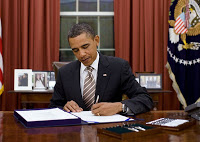President Obama bypassed the Congress on Tuesday and signed the much maligned but anticipated cybersecurity executive order.
He made the announcement during the State of the Union address, stating:
‘We know hackers steal people’s identities and infiltrate private email. We know foreign countries and companies swipe our corporate secrets. Now our enemies are also seeking the ability to sabotage our power grid, our financial institutions, and our air traffic control systems,’ Obama said during his speech. ‘We cannot look back years from now and wonder why we did nothing in the face of real threats to our security and our economy.’
‘That’s why, earlier today, I signed a new executive order that will strengthen our cyber defenses by increasing information sharing, and developing standards to protect our national security, our jobs, and our privacy,’ Obama continued. ‘Now, Congress must act as well, by passing legislation to give our government a greater capacity to secure our networks and deter attacks.’
The privacy-killing cybersecurity legislation CISPA has failed to pass in the Senate in two votes last year which Obama called the “height of irresponsibility.”
As usual, the executive action was “urgent” and “for our safety”. Yet, we already know that the government has already been using the powers vested in the Cyber Intelligence Sharing and Protection Act through the secret Presidential Directive 20 and warrantless cooperation with private communications companies who may act with impunity.
The lengthy executive order does not give federal agencies “new authority”, rather it just spells out more or less who’s in charge — which is the Department of Homeland Security of course:
The cyber order gives the Department of Homeland Security (DHS) a lead role in establishing a voluntary program that encourages critical infrastructure operators to adopt the NIST and industry-developed cybersecurity framework, which is aimed at beefing up the security of their computer systems and networks. DHS will work with agencies, such as the Department of Energy, and industry councils to implement the cybersecurity best practices laid out in the framework, as well as identify possible ways to entice companies to join the voluntary program. (Source: The Hill)
Below is the entire Executive Order called Improving Critical Infrastructure Cybersecurity:
By the authority vested in me as President by the Constitution and the laws of the United States of America, it is hereby ordered as follows:
Section 1. Policy. Repeated cyber intrusions into critical infrastructure demonstrate the need for improved cybersecurity. The cyber threat to critical infrastructure continues to grow and represents one of the most serious national security challenges we must confront. The national and economic security of the United States depends on the reliable functioning of the Nation’s critical infrastructure in the face of such threats. It is the policy of the United States to enhance the security and resilience of the Nation’s critical infrastructure and to maintain a cyber environment that encourages efficiency, innovation, and economic prosperity while promoting safety, security, business confidentiality, privacy, and civil liberties. We can achieve these goals through a partnership with the owners and operators of critical infrastructure to improve cybersecurity information sharing and collaboratively develop and implement risk-based standards.
Sec. 2. Critical Infrastructure. As used in this order, the term critical infrastructure means systems and assets, whether physical or virtual, so vital to the United States that the incapacity or destruction of such systems and assets would have a debilitating impact on security, national economic security, national public health or safety, or any combination of those matters.
Sec. 3. Policy Coordination. Policy coordination, guidance, dispute resolution, and periodic in-progress reviews for the functions and programs described and assigned herein shall be provided through the interagency process established in Presidential Policy Directive-1 of February 13, 2009 (Organization of the National Security Council System), or any successor.
 Sec. 4. Cybersecurity Information Sharing. (a) It is the policy of the United States Government to increase the volume, timeliness, and quality of cyber threat information shared with U.S. private sector entities so that these entities may better protect and defend themselves against cyber threats. Within 120 days of the date of this order, the Attorney General, the Secretary of Homeland Security (the “Secretary”), and the Director of National Intelligence shall each issue instructions consistent with their authorities and with the requirements of section 12(c) of this order to ensure the timely production of unclassified reports of cyber threats to the U.S. homeland that identify a specific targeted entity. The instructions shall address the need to protect intelligence and law enforcement sources, methods, operations, and investigations.
Sec. 4. Cybersecurity Information Sharing. (a) It is the policy of the United States Government to increase the volume, timeliness, and quality of cyber threat information shared with U.S. private sector entities so that these entities may better protect and defend themselves against cyber threats. Within 120 days of the date of this order, the Attorney General, the Secretary of Homeland Security (the “Secretary”), and the Director of National Intelligence shall each issue instructions consistent with their authorities and with the requirements of section 12(c) of this order to ensure the timely production of unclassified reports of cyber threats to the U.S. homeland that identify a specific targeted entity. The instructions shall address the need to protect intelligence and law enforcement sources, methods, operations, and investigations.
(b) The Secretary and the Attorney General, in coordination with the Director of National Intelligence, shall establish a process that rapidly disseminates the reports produced pursuant to section 4(a) of this order to the targeted entity. Such process shall also, consistent with the need to protect national security information, include the dissemination of classified reports to critical infrastructure entities authorized to receive them. The Secretary and the Attorney General, in coordination with the Director of National Intelligence, shall establish a system for tracking the production, dissemination, and disposition of these reports.
(c) To assist the owners and operators of critical infrastructure in protecting their systems from unauthorized access, exploitation, or harm, the Secretary, consistent with 6 U.S.C. 143 and in collaboration with the Secretary of Defense, shall, within 120 days of the date of this order, establish procedures to expand the Enhanced Cybersecurity Services program to all critical infrastructure sectors. This voluntary information sharing program will provide classified cyber threat and technical information from the Government to eligible critical infrastructure companies or commercial service providers that offer security services to critical infrastructure.
(d) The Secretary, as the Executive Agent for the Classified National Security Information Program created under Executive Order 13549 of August 18, 2010 (Classified National Security Information Program for State, Local, Tribal, and Private Sector Entities), shall expedite the processing of security clearances to appropriate personnel employed by critical infrastructure owners and operators, prioritizing the critical infrastructure identified in section 9 of this order.
(e) In order to maximize the utility of cyber threat information sharing with the private sector, the Secretary shall expand the use of programs that bring private sector subject-matter experts into Federal service on a temporary basis. These subject matter experts should provide advice regarding the content, structure, and types of information most useful to critical infrastructure owners and operators in reducing and mitigating cyber risks.
Sec. 5. Privacy and Civil Liberties Protections. (a) Agencies shall coordinate their activities under this order with their senior agency officials for privacy and civil liberties and ensure that privacy and civil liberties protections are incorporated into such activities. Such protections shall be based upon the Fair Information Practice Principles and other privacy and civil liberties policies, principles, and frameworks as they apply to each agency’s activities.
 (b) The Chief Privacy Officer and the Officer for Civil Rights and Civil Liberties of the Department of Homeland Security (DHS) shall assess the privacy and civil liberties risks of the functions and programs undertaken by DHS as called for in this order and shall recommend to the Secretary ways to minimize or mitigate such risks, in a publicly available report, to be released within 1 year of the date of this order. Senior agency privacy and civil liberties officials for other agencies engaged in activities under this order shall conduct assessments of their agency activities and provide those assessments to DHS for consideration and inclusion in the report. The report shall be reviewed on an annual basis and revised as necessary. The report may contain a classified annex if necessary. Assessments shall include evaluation of activities against the Fair Information Practice Principles and other applicable privacy and civil liberties policies, principles, and frameworks. Agencies shall consider the assessments and recommendations of the report in implementing privacy and civil liberties protections for agency activities.
(b) The Chief Privacy Officer and the Officer for Civil Rights and Civil Liberties of the Department of Homeland Security (DHS) shall assess the privacy and civil liberties risks of the functions and programs undertaken by DHS as called for in this order and shall recommend to the Secretary ways to minimize or mitigate such risks, in a publicly available report, to be released within 1 year of the date of this order. Senior agency privacy and civil liberties officials for other agencies engaged in activities under this order shall conduct assessments of their agency activities and provide those assessments to DHS for consideration and inclusion in the report. The report shall be reviewed on an annual basis and revised as necessary. The report may contain a classified annex if necessary. Assessments shall include evaluation of activities against the Fair Information Practice Principles and other applicable privacy and civil liberties policies, principles, and frameworks. Agencies shall consider the assessments and recommendations of the report in implementing privacy and civil liberties protections for agency activities.
(c) In producing the report required under subsection (b) of this section, the Chief Privacy Officer and the Officer for Civil Rights and Civil Liberties of DHS shall consult with the Privacy and Civil Liberties Oversight Board and coordinate with the Office of Management and Budget (OMB).
(d) Information submitted voluntarily in accordance with 6 U.S.C. 133 by private entities under this order shall be protected from disclosure to the fullest extent permitted by law.
Sec. 6. Consultative Process. The Secretary shall establish a consultative process to coordinate improvements to the cybersecurity of critical infrastructure. As part of the consultative process, the Secretary shall engage and consider the advice, on matters set forth in this order, of the Critical Infrastructure Partnership Advisory Council; Sector Coordinating Councils; critical infrastructure owners and operators; Sector-Specific Agencies; other relevant agencies; independent regulatory agencies; State, local, territorial, and tribal governments; universities; and outside experts.
Sec. 7. Baseline Framework to Reduce Cyber Risk to Critical Infrastructure. (a) The Secretary of Commerce shall direct the Director of the National Institute of Standards and Technology (the “Director”) to lead the development of a framework to reduce cyber risks to critical infrastructure (the “Cybersecurity Framework”). The Cybersecurity Framework shall include a set of standards, methodologies, procedures, and processes that align policy, business, and technological approaches to address cyber risks. The Cybersecurity Framework shall incorporate voluntary consensus standards and industry best practices to the fullest extent possible. The Cybersecurity Framework shall be consistent with voluntary international standards when such international standards will advance the objectives of this order, and shall meet the requirements of the National Institute of Standards and Technology Act, as amended (15 U.S.C. 271 et seq.), the National Technology Transfer and Advancement Act of 1995 (Public Law 104-113), and OMB Circular A-119, as revised.
(b) The Cybersecurity Framework shall provide a prioritized, flexible, repeatable, performance-based, and cost-effective approach, including information security measures and controls, to help owners and operators of critical infrastructure identify, assess, and manage cyber risk. The Cybersecurity Framework shall focus on identifying cross-sector security standards and guidelines applicable to critical infrastructure. The Cybersecurity Framework will also identify areas for improvement that should be addressed through future collaboration with particular sectors and standards-developing organizations. To enable technical innovation and account for organizational differences, the Cybersecurity Framework will provide guidance that is technology neutral and that enables critical infrastructure sectors to benefit from a competitive market for products and services that meet the standards, methodologies, procedures, and processes developed to address cyber risks. The Cybersecurity Framework shall include guidance for measuring the performance of an entity in implementing the Cybersecurity Framework.
(c) The Cybersecurity Framework shall include methodologies to identify and mitigate impacts of the Cybersecurity Framework and associated information security measures or controls on business confidentiality, and to protect individual privacy and civil liberties.
 (d) In developing the Cybersecurity Framework, the Director shall engage in an open public review and comment process. The Director shall also consult with the Secretary, the National Security Agency, Sector-Specific Agencies and other interested agencies including OMB, owners and operators of critical infrastructure, and other stakeholders through the consultative process established in section 6 of this order. The Secretary, the Director of National Intelligence, and the heads of other relevant agencies shall provide threat and vulnerability information and technical expertise to inform the development of the Cybersecurity Framework. The Secretary shall provide performance goals for the Cybersecurity Framework informed by work under section 9 of this order.
(d) In developing the Cybersecurity Framework, the Director shall engage in an open public review and comment process. The Director shall also consult with the Secretary, the National Security Agency, Sector-Specific Agencies and other interested agencies including OMB, owners and operators of critical infrastructure, and other stakeholders through the consultative process established in section 6 of this order. The Secretary, the Director of National Intelligence, and the heads of other relevant agencies shall provide threat and vulnerability information and technical expertise to inform the development of the Cybersecurity Framework. The Secretary shall provide performance goals for the Cybersecurity Framework informed by work under section 9 of this order.
(e) Within 240 days of the date of this order, the Director shall publish a preliminary version of the Cybersecurity Framework (the “preliminary Framework”). Within 1 year of the date of this order, and after coordination with the Secretary to ensure suitability under section 8 of this order, the Director shall publish a final version of the Cybersecurity Framework (the “final Framework”).
(f) Consistent with statutory responsibilities, the Director will ensure the Cybersecurity Framework and related guidance is reviewed and updated as necessary, taking into consideration technological changes, changes in cyber risks, operational feedback from owners and operators of critical infrastructure, experience from the implementation of section 8 of this order, and any other relevant factors.
Sec. 8. Voluntary Critical Infrastructure Cybersecurity Program. (a) The Secretary, in coordination with Sector-Specific Agencies, shall establish a voluntary program to support the adoption of the Cybersecurity Framework by owners and operators of critical infrastructure and any other interested entities (the “Program”).
(b) Sector-Specific Agencies, in consultation with the Secretary and other interested agencies, shall coordinate with the Sector Coordinating Councils to review the Cybersecurity Framework and, if necessary, develop implementation guidance or supplemental materials to address sector-specific risks and operating environments.
(c) Sector-Specific Agencies shall report annually to the President, through the Secretary, on the extent to which owners and operators notified under section 9 of this order are participating in the Program.
(d) The Secretary shall coordinate establishment of a set of incentives designed to promote participation in the Program. Within 120 days of the date of this order, the Secretary and the Secretaries of the Treasury and Commerce each shall make recommendations separately to the President, through the Assistant to the President for Homeland Security and Counterterrorism and the Assistant to the President for Economic Affairs, that shall include analysis of the benefits and relative effectiveness of such incentives, and whether the incentives would require legislation or can be provided under existing law and authorities to participants in the Program.
(e) Within 120 days of the date of this order, the Secretary of Defense and the Administrator of General Services, in consultation with the Secretary and the Federal Acquisition Regulatory Council, shall make recommendations to the President, through the Assistant to the President for Homeland Security and Counterterrorism and the Assistant to the President for Economic Affairs, on the feasibility, security benefits, and relative merits of incorporating security standards into acquisition planning and contract administration. The report shall address what steps can be taken to harmonize and make consistent existing procurement requirements related to cybersecurity.
Sec. 9. Identification of Critical Infrastructure at Greatest Risk. (a) Within 150 days of the date of this order, the Secretary shall use a risk-based approach to identify critical infrastructure where a cybersecurity incident could reasonably result in catastrophic regional or national effects on public health or safety, economic security, or national security. In identifying critical infrastructure for this purpose, the Secretary shall use the consultative process established in section 6 of this order and draw upon the expertise of Sector-Specific Agencies. The Secretary shall apply consistent, objective criteria in identifying such critical infrastructure. The Secretary shall not identify any commercial information technology products or consumer information technology services under this section. The Secretary shall review and update the list of identified critical infrastructure under this section on an annual basis, and provide such list to the President, through the Assistant to the President for Homeland Security and Counterterrorism and the Assistant to the President for Economic Affairs.
(b) Heads of Sector-Specific Agencies and other relevant agencies shall provide the Secretary with information necessary to carry out the responsibilities under this section. The Secretary shall develop a process for other relevant stakeholders to submit information to assist in making the identifications required in subsection (a) of this section.
 (c) The Secretary, in coordination with Sector-Specific Agencies, shall confidentially notify owners and operators of critical infrastructure identified under subsection (a) of this section that they have been so identified, and ensure identified owners and operators are provided the basis for the determination. The Secretary shall establish a process through which owners and operators of critical infrastructure may submit relevant information and request reconsideration of identifications under subsection (a) of this section.
(c) The Secretary, in coordination with Sector-Specific Agencies, shall confidentially notify owners and operators of critical infrastructure identified under subsection (a) of this section that they have been so identified, and ensure identified owners and operators are provided the basis for the determination. The Secretary shall establish a process through which owners and operators of critical infrastructure may submit relevant information and request reconsideration of identifications under subsection (a) of this section.
Sec. 10. Adoption of Framework. (a) Agencies with responsibility for regulating the security of critical infrastructure shall engage in a consultative process with DHS, OMB, and the National Security Staff to review the preliminary Cybersecurity Framework and determine if current cybersecurity regulatory requirements are sufficient given current and projected risks. In making such determination, these agencies shall consider the identification of critical infrastructure required under section 9 of this order. Within 90 days of the publication of the preliminary Framework, these agencies shall submit a report to the President, through the Assistant to the President for Homeland Security and Counterterrorism, the Director of OMB, and the Assistant to the President for Economic Affairs, that states whether or not the agency has clear authority to establish requirements based upon the Cybersecurity Framework to sufficiently address current and projected cyber risks to critical infrastructure, the existing authorities identified, and any additional authority required.
(b) If current regulatory requirements are deemed to be insufficient, within 90 days of publication of the final Framework, agencies identified in subsection (a) of this section shall propose prioritized, risk-based, efficient, and coordinated actions, consistent with Executive Order 12866 of September 30, 1993 (Regulatory Planning and Review), Executive Order 13563 of January 18, 2011 (Improving Regulation and Regulatory Review), and Executive Order 13609 of May 1, 2012 (Promoting International Regulatory Cooperation), to mitigate cyber risk.
(c) Within 2 years after publication of the final Framework, consistent with Executive Order 13563 and Executive Order 13610 of May 10, 2012 (Identifying and Reducing Regulatory Burdens), agencies identified in subsection (a) of this section shall, in consultation with owners and operators of critical infrastructure, report to OMB on any critical infrastructure subject to ineffective, conflicting, or excessively burdensome cybersecurity requirements. This report shall describe efforts made by agencies, and make recommendations for further actions, to minimize or eliminate such requirements.
(d) The Secretary shall coordinate the provision of technical assistance to agencies identified in subsection (a) of this section on the development of their cybersecurity workforce and programs.
(e) Independent regulatory agencies with responsibility for regulating the security of critical infrastructure are encouraged to engage in a consultative process with the Secretary, relevant Sector-Specific Agencies, and other affected parties to consider prioritized actions to mitigate cyber risks for critical infrastructure consistent with their authorities.
Sec. 11. Definitions. (a) “Agency” means any authority of the United States that is an “agency” under 44 U.S.C. 3502(1), other than those considered to be independent regulatory agencies, as defined in 44 U.S.C. 3502(5).
 (b) “Critical Infrastructure Partnership Advisory Council” means the council established by DHS under 6 U.S.C. 451 to facilitate effective interaction and coordination of critical infrastructure protection activities among the Federal Government; the private sector; and State, local, territorial, and tribal governments.
(b) “Critical Infrastructure Partnership Advisory Council” means the council established by DHS under 6 U.S.C. 451 to facilitate effective interaction and coordination of critical infrastructure protection activities among the Federal Government; the private sector; and State, local, territorial, and tribal governments.
(c) “Fair Information Practice Principles” means the eight principles set forth in Appendix A of the National Strategy for Trusted Identities in Cyberspace.
(d) “Independent regulatory agency” has the meaning given the term in 44 U.S.C. 3502(5).
(e) “Sector Coordinating Council” means a private sector coordinating council composed of representatives of owners and operators within a particular sector of critical infrastructure established by the National Infrastructure Protection Plan or any successor.
(f) “Sector-Specific Agency” has the meaning given the term in Presidential Policy Directive-21 of February 12, 2013 (Critical Infrastructure Security and Resilience), or any successor.
Sec. 12. General Provisions. (a) This order shall be implemented consistent with applicable law and subject to the availability of appropriations. Nothing in this order shall be construed to provide an agency with authority for regulating the security of critical infrastructure in addition to or to a greater extent than the authority the agency has under existing law. Nothing in this order shall be construed to alter or limit any authority or responsibility of an agency under existing law.
(b) Nothing in this order shall be construed to impair or otherwise affect the functions of the Director of OMB relating to budgetary, administrative, or legislative proposals.
(c) All actions taken pursuant to this order shall be consistent with requirements and authorities to protect intelligence and law enforcement sources and methods. Nothing in this order shall be interpreted to supersede measures established under authority of law to protect the security and integrity of specific activities and associations that are in direct support of intelligence and law enforcement operations.
(d) This order shall be implemented consistent with U.S. international obligations.
(e) This order is not intended to, and does not, create any right or benefit, substantive or procedural, enforceable at law or in equity by any party against the United States, its departments, agencies, or entities, its officers, employees, or agents, or any other person.
(Source:WhiteHouse.gov)
Read other articles by Activist Post Here
linkwithin_text=’Related Articles:’



Be the first to comment on "Obama Signs Cybersecurity Executive Order"